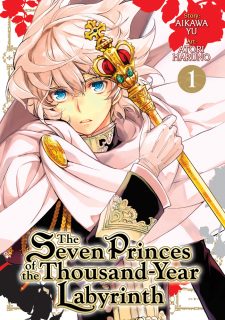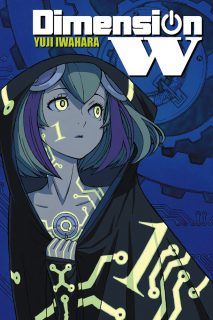My News and Reviews
Last week at Experiments in Manga I posted the Bookshelf Overload for January–it was kind of a strange month for manga and other media acquisitions for me, but it wasn’t as absurd as December so at least my wallet’s a little happier. I also managed to finish my draft for February’s in-depth review, so I should have that cleaned up and posted sometime later this week.
Last week I came across a few interesting things online related to queer manga, comics, and other media. Massive has now released Jiraiya’s Two Hoses in English, a manga telling the story of “The Greatest Couple,” characters who were initially designed for the company as part of its launch. (Massive has released Jiraiya’s Caveman Guu manga, too, which was subsequently collected in the excellent anthology Massive: Gay Erotic Manga and the Men Who Make It.)
I haven’t had a chance to actually listen to it yet, but the most recent ANNCast focused on LGBT representation in manga and anime with guests Erica Friedman, Jason Thompson, and Valerie Complex. Friedman also visited the University of Michigan back in January to discuss queer manga. The recording of her presentation Alt Manga, Queer Manga: Telling Our Own Stories is now available to watch on YouTube.
There were a few Kickstarter campaigns that caught my attention last week as well. First and foremost, Chromatic Press is raising funds to release the final volume of Lianne Sentar’s series Tokyo Demons in print, produce a revised edition of the first novel, as well as reprint the other books in the series. It isn’t a secret that I am a huge fan of the series, so I definitely want to see the project succeed. Tabula Idem is a great-looking tarot-themed queer comics anthology with an accompanying queer-themed major arcana tarot deck. I’m not very familiar with most of the artists involved, but Kaiju (whose comics I greatly enjoy) is contributing the cover illustration. Pamela Kotila has also launched a campaign to print the second volume of the webcomic Spidersilk. Though I haven’t actually read it yet, I recently picked up the first volume so this project seems to be aptly-timed.
Quick Takes
 The Ancient Magus’ Bride, Volumes 4-6 by Kore Yamazaki. It’s been a little while since I’ve read The Ancient Magus’ Bride but that’s not because I don’t like the manga. In fact, it’s quite the opposite–The Ancient Magus’ Bride is actually one of my favorite series currently being released in English. I simply wanted to have a whole stack of volumes to read all at once. (Also worth noting: The first printing of Volume 6 is even accompanied by a special booklet with an additional comic!) Somehow, I had managed to forget just how much I enjoy The Ancient Magus’ Bride. I love its moody atmosphere and setting, beautiful artwork, and intriguing characters. Elias remains something of an enigma although parts of his past have now been revealed. He isn’t particularly happy about this development, though. Likewise, more is known about Chise, too, although she is still hesitant to share. The relationship dynamics in The Ancient Magus’ Bride are somewhat peculiar but remain compelling. Most of the characters in the manga are struggling with some sort of heartbreaking loneliness or feelings of isolation. To see them slowly drawing closer together, forming bonds of friendship, family, and love is immensely satisfying.
The Ancient Magus’ Bride, Volumes 4-6 by Kore Yamazaki. It’s been a little while since I’ve read The Ancient Magus’ Bride but that’s not because I don’t like the manga. In fact, it’s quite the opposite–The Ancient Magus’ Bride is actually one of my favorite series currently being released in English. I simply wanted to have a whole stack of volumes to read all at once. (Also worth noting: The first printing of Volume 6 is even accompanied by a special booklet with an additional comic!) Somehow, I had managed to forget just how much I enjoy The Ancient Magus’ Bride. I love its moody atmosphere and setting, beautiful artwork, and intriguing characters. Elias remains something of an enigma although parts of his past have now been revealed. He isn’t particularly happy about this development, though. Likewise, more is known about Chise, too, although she is still hesitant to share. The relationship dynamics in The Ancient Magus’ Bride are somewhat peculiar but remain compelling. Most of the characters in the manga are struggling with some sort of heartbreaking loneliness or feelings of isolation. To see them slowly drawing closer together, forming bonds of friendship, family, and love is immensely satisfying.
 Mr. Mini Mart by Junko. Although the boys’ love manga Mr. Mini Mart was released in English first, my introduction to Junko’s work was through the series Kiss Him, Not Me. Because I was enjoying that series, I made a point to track down a copy of Mr. Mini Mart which for a time had gone out-of-print. (It’s more-or-less back in print again, but the manga seems to only be available directly from Juné Manga’s online store.) I forget why I initially passed on Mr. Mini Mart but I’m very glad that I finally got around to reading it. Mr. Mini Mart collects two boys’ love stories. Most of the volume is devoted to the titular “Mr. Mini Mart” but a short, unrelated one-shot manga “Young Scrubs” is included as well. It’s not nearly as good, though. “Mr. Mini Mart” is wonderful and surprisingly sweet. The story follows the high-school-aged Nakaba who, after an unfortunate incident in middle school, has been living as a shut-in. He gets finally gets out of the house when his uncle gives him a job at his store, but Nakaba has a difficult time getting along with his coworker Yamai and his abrasive personality. I’ll admit, I’m a sucker for a sensitive tough guy and it turns out that Yamai is an amazing example of one and is just a great person in general.
Mr. Mini Mart by Junko. Although the boys’ love manga Mr. Mini Mart was released in English first, my introduction to Junko’s work was through the series Kiss Him, Not Me. Because I was enjoying that series, I made a point to track down a copy of Mr. Mini Mart which for a time had gone out-of-print. (It’s more-or-less back in print again, but the manga seems to only be available directly from Juné Manga’s online store.) I forget why I initially passed on Mr. Mini Mart but I’m very glad that I finally got around to reading it. Mr. Mini Mart collects two boys’ love stories. Most of the volume is devoted to the titular “Mr. Mini Mart” but a short, unrelated one-shot manga “Young Scrubs” is included as well. It’s not nearly as good, though. “Mr. Mini Mart” is wonderful and surprisingly sweet. The story follows the high-school-aged Nakaba who, after an unfortunate incident in middle school, has been living as a shut-in. He gets finally gets out of the house when his uncle gives him a job at his store, but Nakaba has a difficult time getting along with his coworker Yamai and his abrasive personality. I’ll admit, I’m a sucker for a sensitive tough guy and it turns out that Yamai is an amazing example of one and is just a great person in general.
 The Seven Princes of the Thousand-Year Labyrinth, Volume 1 written by Yu Aikawa and illustrated by Haruno Atori. I really wanted to like the first volume of The Seven Princes of the Thousand-Year Labyrinth more than I actually did. The basic premise is intriguing. A group of some of the kingdom’s most noteworthy, and in some cases most notorious, citizens wake up to find themselves trapped together in an elaborately booby-trapped castle. (The exception is the protagonist Ewan whose only distinguishing characteristics are his trusting nature, inherent kindness, and the fact that he’s from the kingdom’s most remote island.) The assumption is that whoever manages to survive the ordeal will become the kingdom’s emperor and reigning lords. There is a ton of potential in this set up, but The Seven Princes of the Thousand-Year Labyrinth simply didn’t work for me. Mostly I think it’s because the characters all come across as types rather than well-rounded individuals. What’s more is that they don’t even feel like they should all be a part of the same series; I found this lack of cohesiveness to be frustrating. The artwork is pretty, though, if not especially distinctive and there are plenty of plot twists, too.
The Seven Princes of the Thousand-Year Labyrinth, Volume 1 written by Yu Aikawa and illustrated by Haruno Atori. I really wanted to like the first volume of The Seven Princes of the Thousand-Year Labyrinth more than I actually did. The basic premise is intriguing. A group of some of the kingdom’s most noteworthy, and in some cases most notorious, citizens wake up to find themselves trapped together in an elaborately booby-trapped castle. (The exception is the protagonist Ewan whose only distinguishing characteristics are his trusting nature, inherent kindness, and the fact that he’s from the kingdom’s most remote island.) The assumption is that whoever manages to survive the ordeal will become the kingdom’s emperor and reigning lords. There is a ton of potential in this set up, but The Seven Princes of the Thousand-Year Labyrinth simply didn’t work for me. Mostly I think it’s because the characters all come across as types rather than well-rounded individuals. What’s more is that they don’t even feel like they should all be a part of the same series; I found this lack of cohesiveness to be frustrating. The artwork is pretty, though, if not especially distinctive and there are plenty of plot twists, too.
 Tomie by Junji Ito. Although uncommon, license rescues aren’t particularly rare, but Ito’s horror series Tomie is one of the very few manga to have been released in English by three different publishers. Most recently, Viz Media has collected the entire series in a single, massive tome with over seven hundred forty pages. The translation used is the same as the one in Dark Horse’s Museum of Terror series which I own, but I couldn’t resist the deluxe, hardcover treatment the volume received to match Viz’s other recent re-releases of Ito’s manga. Tomie was actually Ito’s award-winning professional debut and began serialization in 1987 in a shoujo magazine. The manga is largely episodic although there may be several chapters devoted to a single story arc and later stories sometimes make passing references to earlier ones. What ties the series together is the presence of Tomie, a beautiful young woman who is seemingly immortal. Time and again men fall desperately in love with Tomie and are eventually overcome by a desire to murder and dismember her. Not only does Tomie survive, she regenerates and multiplies, and so the horror continues. While not as mind-bendingly bizarre as some of Ito’s later works, Tomie is still weird, horrifying, gruesome, and grotesque.
Tomie by Junji Ito. Although uncommon, license rescues aren’t particularly rare, but Ito’s horror series Tomie is one of the very few manga to have been released in English by three different publishers. Most recently, Viz Media has collected the entire series in a single, massive tome with over seven hundred forty pages. The translation used is the same as the one in Dark Horse’s Museum of Terror series which I own, but I couldn’t resist the deluxe, hardcover treatment the volume received to match Viz’s other recent re-releases of Ito’s manga. Tomie was actually Ito’s award-winning professional debut and began serialization in 1987 in a shoujo magazine. The manga is largely episodic although there may be several chapters devoted to a single story arc and later stories sometimes make passing references to earlier ones. What ties the series together is the presence of Tomie, a beautiful young woman who is seemingly immortal. Time and again men fall desperately in love with Tomie and are eventually overcome by a desire to murder and dismember her. Not only does Tomie survive, she regenerates and multiplies, and so the horror continues. While not as mind-bendingly bizarre as some of Ito’s later works, Tomie is still weird, horrifying, gruesome, and grotesque.

















